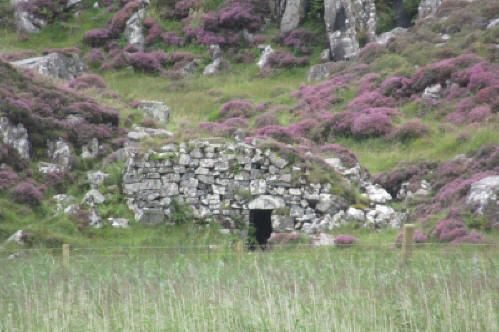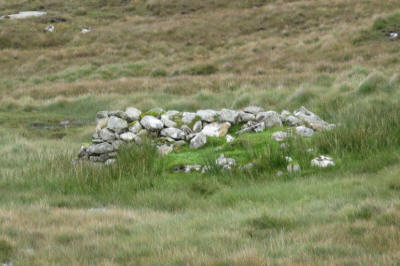|
   |
|
Page 6 |
Newsletter 127 Winter 2019 © Hampshire Mills Group |
|
Siabost Norse Mill – Postscript
Ruth Andrews
|
|
Keith and I visited the Western Isles in September.
On the Isle of Lewis we went in search of the
set of 4 Norse mills that the guide book mentioned
at Valtos, and for which it gave an
apparently very clear set of instructions to get
there. We eventually found the lowest mill but
could not get near it or to see the other 3 mills
higher up the stream because heavy rainfall had
enlarged the intervening marsh and bog, and a stile
at the start of the walk had been removed, which
caused us to set off in the wrong direction.
|
 |
 |
|
We were more successful at collecting information.
I bought
The Norse Mills of Lewis
by Finlay MacLeod (a member of TIMS) with drawings
by John Love (Acair 2009, ISBN 978086 1523627, also
available in a fully Gaelic version) which was a
good purchase. As the book reports, in 1850 there
were 114 intact and 58 derelict sites on Lewis
alone. Today over 250 are known, almost all of
which now have very little or no remains.
|
|
There were also 5 vertical mills which were built by
proprietors or other wealthy individuals and
collected a levy of 1/16 of the grain milled. They
were situated at Stornoway 1718, burnt down in
1890, and replaced by Garabost; Griais 1820 (right);
Nis 1830; and Breascleit. |
 |
|
The Norse mills were local and free, and suited the
relatively small quantities of bere and oats being
grown in ‘lazy beds’ on the crofts, and so continued
to be used until about the first world war. The
book relates that the wife of a fisherman could
reap, dry, sieve, and mill the barley, and bake it
into a bannock all in the time that it took the
fisherman to get ready. Once he had caught his
first cod he would insert the fresh liver into the
bannock and sit on it on the thwart to allow the
melting liver to infuse the bannock; and then eat
it!
The book also provided more information on kilns.
The kiln ‘bowl’ or recess was topped by two boulders
supporting a wooden cross beam with shorter beams
forming a miniature roof. This was then covered in
straw and the grain was scattered in top to a depth
of 3in. Sheaves were placed on the platform to stop
the grain from sliding off. When it was dry the
sheaves were removed, allowing the grain to slide
off onto the platform. |
|

From theardbernera.com
|
It was in 1970 that Siabost Junior Secondary School
rebuilt the mill at Siabost (Muileann nan
Gobhaichean) and a new kiln was later built from
scratch alongside.
Something similar has happened on Great Bernara at
Breacleit (Muileann Bhreacleit) which the book
describes as “a most attractive mill in its perfect
setting” (left). Unfortunately we didn’t manage to
get there either as it is difficult to reach across
several wild and stony hillsides despite the signed
footpath. I can only salute the local historical
society who undertook its restoration.
All the Norse mills on Lewis seem to have had
similar boulder-built walls with wood and straw
domed roofs which do not survive well, while the
millstones tend to end up miles away as garden
ornaments and such like. So Siabost is a noteworthy
survival.
|
 |
 |
|
Mill site at Einacleit compared with restored mill
at Siabost
|
|
However, after our failures on Lewis, we did come
across one site with the remains of the mill
building and water course on the west coast of
Sutherland at Clashnessie, which we later
confirmed from Canmore (National Record of the
Historic Environment, Scotland) to be a Norse mill
dating from the 18th to 19th century. |
 |
|
|
